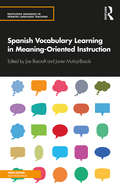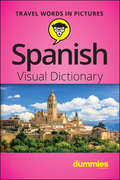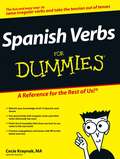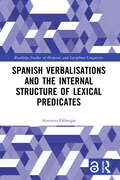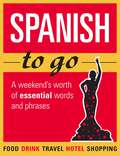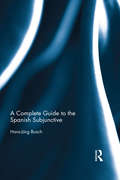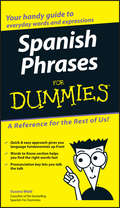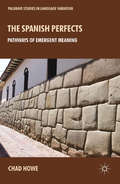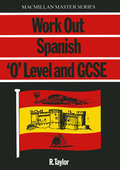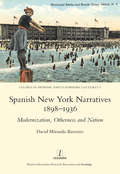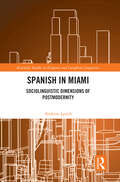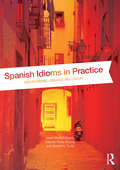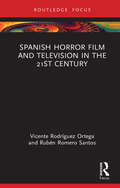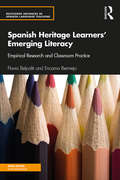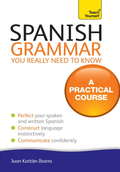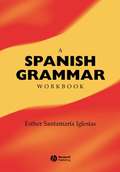- Table View
- List View
Spanish Vocabulary Learning in Meaning-Oriented Instruction (Routledge Advances in Spanish Language Teaching)
by Joe Barcroft Javier Muñoz-BasolsSpanish Vocabulary Learning in Meaning-Oriented Instruction is the first comprehensive overview of current research and instructional practices into Spanish vocabulary acquisition through the lens of Meaning-Oriented Instruction (MOI). Key features: • a breadth of topics including language variation, input, tasks and processing specificity, incidental learning, idiomatic language, lexicographic perspectives, lexicosemantic representation, vocabulary testing, and receptive and productive vocabulary; • a combination of theory and practical guidance highlighting pedagogical best practices in the teaching of vocabulary; • guidance on the difficulties teachers face when teaching vocabulary in the classroom; • clear explanations with plenty of examples and useful references; • tasks and activities that help teachers move from a traditional curricular approach to a more innovative and engaging one focused on communicating, completing tasks, and learning content. Written by an international cohort of scholars in a succinct and accessible manner, Spanish Vocabulary Learning in Meaning-Oriented Instruction is an essential resource for teachers of Spanish at all levels. It is also an excellent reference book for researchers and both undergraduate and graduate students interested in Spanish vocabulary acquisition.
Spanish Vocabulary Learning in Meaning-Oriented Instruction (Routledge Advances in Spanish Language Teaching)
by Joe Barcroft Javier Muñoz-BasolsSpanish Vocabulary Learning in Meaning-Oriented Instruction is the first comprehensive overview of current research and instructional practices into Spanish vocabulary acquisition through the lens of Meaning-Oriented Instruction (MOI). Key features: • a breadth of topics including language variation, input, tasks and processing specificity, incidental learning, idiomatic language, lexicographic perspectives, lexicosemantic representation, vocabulary testing, and receptive and productive vocabulary; • a combination of theory and practical guidance highlighting pedagogical best practices in the teaching of vocabulary; • guidance on the difficulties teachers face when teaching vocabulary in the classroom; • clear explanations with plenty of examples and useful references; • tasks and activities that help teachers move from a traditional curricular approach to a more innovative and engaging one focused on communicating, completing tasks, and learning content. Written by an international cohort of scholars in a succinct and accessible manner, Spanish Vocabulary Learning in Meaning-Oriented Instruction is an essential resource for teachers of Spanish at all levels. It is also an excellent reference book for researchers and both undergraduate and graduate students interested in Spanish vocabulary acquisition.
Spanish Visual Dictionary For Dummies
by Consumer DummiesSpanish Visual Dictionary Learn Spanish vocabulary faster!It’s a fact—seeing something helps you remember it. This handy guide helps you build your Spanish vocabulary with full-color pictures illustrating every term. You’ll be able to communicate with native speakers faster as you learn and remember more words and their meanings. The book is organized by themes such as transportation, accommodations, restaurants and eating, sports, emergencies, and shopping, making it especially useful for travelers. Boost your learning speed and get talking in Spanish today!InsideTransportation terminologyGetting around a cityRestaurants and food ordersHandling an emergency
Spanish Visual Dictionary For Dummies
by Consumer DummiesSpanish Visual Dictionary Learn Spanish vocabulary faster!It’s a fact—seeing something helps you remember it. This handy guide helps you build your Spanish vocabulary with full-color pictures illustrating every term. You’ll be able to communicate with native speakers faster as you learn and remember more words and their meanings. The book is organized by themes such as transportation, accommodations, restaurants and eating, sports, emergencies, and shopping, making it especially useful for travelers. Boost your learning speed and get talking in Spanish today!InsideTransportation terminologyGetting around a cityRestaurants and food ordersHandling an emergency
Spanish Verbs For Dummies
by Cecie KraynakA fun, comprehensive way to get up to speed on Spanish With over 325 million speakers, Spanish is in a virtual dead heat with English as the second most popular spoken language. This easy-to-follow guide shows readers how to successfully conjugate verbs, providing easy, entertaining exercises and answer keys to reinforce different grammatical rules. More than just a dictionary-style list of verbs, Spanish Verbs For Dummies covers regular verbs in the present tense and six other simple tenses, interrogatives and imperatives, irregular verbs in all seven tenses, and Spanish verb nuances. Mary Kraynak, MA (Indianapolis, IN), teaches Spanish to junior high and high school students and has served as a technical consultant to several Spanish learning guides.
Spanish Verbalisations and the Internal Structure of Lexical Predicates (Routledge Studies in Hispanic and Lusophone Linguistics)
by Antonio FábregasSpanish Verbalisations and the Internal Structure of Lexical Predicates provides the first comprehensive and empirically detailed theoretical analysis of the different ways in which Spanish builds verbs from nouns and adjectives. This book poses questions about the nature of theme vowels, parasynthesis and the structural relation between the three major lexical word classes from within a Neo-Constructionist framework that highlights the correlations between the syntactic and semantic behaviour of verbs and their morphological make up. Provided within are detailed empirical descriptions of each of the nine major ways of building lexical verbs in Spanish, as well as an integral analysis of those patterns that shows the significance of the contrast between them and their uses to address some foundational questions in morphological theory. Spanish Verbalisations will be of particular interest to researchers in formal linguistics and Spanish. The Open Access version of this book, available at www.taylorfrancis.com, has been made available under a Creative Commons Attribution 4.0 license.
Spanish Verbalisations and the Internal Structure of Lexical Predicates (Routledge Studies in Hispanic and Lusophone Linguistics)
by Antonio FábregasSpanish Verbalisations and the Internal Structure of Lexical Predicates provides the first comprehensive and empirically detailed theoretical analysis of the different ways in which Spanish builds verbs from nouns and adjectives. This book poses questions about the nature of theme vowels, parasynthesis and the structural relation between the three major lexical word classes from within a Neo-Constructionist framework that highlights the correlations between the syntactic and semantic behaviour of verbs and their morphological make up. Provided within are detailed empirical descriptions of each of the nine major ways of building lexical verbs in Spanish, as well as an integral analysis of those patterns that shows the significance of the contrast between them and their uses to address some foundational questions in morphological theory. Spanish Verbalisations will be of particular interest to researchers in formal linguistics and Spanish. The Open Access version of this book, available at www.taylorfrancis.com, has been made available under a Creative Commons Attribution 4.0 license.
Spanish to go: A weekend's worth of essential words and phrases
by Martin RodriguezGetting to grips with a foreign language is never easy, and most phrase books are too convoluted to help you when you really need it. Spanish to go is here to help. Using everyday Spanish for everyday scenarios, this book is your passport to survival at the airport, in bars and restaurants, hotels or wherever you end up. Providing you with essential words and phrases for the most practical of situations, all with phonetic pronunciations to make tackling Spanish that little bit easier, Spanish to go has you covered.
The Spanish Subjunctive: A Reference for Teachers
by Hans-Jorg BuschA Complete Guide to the Spanish Subjunctive is the most complete reference guide to the use of the subjunctive in Spanish. Along with an exhaustive review of published literature on the subjunctive, the book also includes a thorough discussion of the uses and meanings of the subjunctive as well as examples throughout drawn from linguistic corpora such as the CREA database. The book presents a comprehensive theory of the subjunctive and provides practical rules for understanding, teaching and acquiring the Spanish subjunctive. This book includes: "Your Turn" sections that invite readers to reflect on the content discussed and on their own experiences in teaching the subjunctive A "Synopsis" section that summarizes the content of the work and offers practical suggestions for teaching the subjunctive Two indexes providing a summary of verb conjugation in the subjunctive and an alphabetical list of expressions used with the subjunctive.
The Spanish Subjunctive: A Reference for Teachers
by Hans-Jorg BuschA Complete Guide to the Spanish Subjunctive is the most complete reference guide to the use of the subjunctive in Spanish. Along with an exhaustive review of published literature on the subjunctive, the book also includes a thorough discussion of the uses and meanings of the subjunctive as well as examples throughout drawn from linguistic corpora such as the CREA database. The book presents a comprehensive theory of the subjunctive and provides practical rules for understanding, teaching and acquiring the Spanish subjunctive. This book includes: "Your Turn" sections that invite readers to reflect on the content discussed and on their own experiences in teaching the subjunctive A "Synopsis" section that summarizes the content of the work and offers practical suggestions for teaching the subjunctive Two indexes providing a summary of verb conjugation in the subjunctive and an alphabetical list of expressions used with the subjunctive.
Spanish Phrases For Dummies
by Susana WaldThe fun and easy way to speak Spanish With Mexico the #1 international destination for Americans, over 14 million secondary school students enrolled in Spanish classes, and Spanish the primary language in many neighborhoods from L.A. to Miami, this should easily be the most popular title in our new phrase book series, following in the footsteps of Spanish For Dummies (0-7645-5194-9), which has sold more than 300,000 copies. Susana Wald is a writer, teacher, and translator.
The Spanish Perfects: Pathways of Emergent Meaning (Palgrave Studies in Language Variation)
by L. HoweThis book considers the role of cross-dialectal data in our understanding of linguistic variability, focusing on the widely discussed dichotomy between past tense forms and relying primarily on spoken language data from different varieties of Spanish.
Spanish New York Narratives 1898-1936: Modernization, Otherness and Nation
by David Miranda-BarreiroIn the early decades of the twentieth century, New York caught the attention of Spanish writers. Many of them visited the city and returned to tell their experience in the form of a literary text. That is the case of Pruebas de Nueva York (1927) by Jose Moreno Villa (1887-1955), El crisol de las razas (1929) by Teresa de Escoriaza (1891-1968), Anticipolis (1931) by Luis de Oteyza (1883-1961) and La ciudad automatica (1932) by Julio Camba (1882-1962). In tune with similar representations in other European works, the image of New York given in these texts reflects the tensions and anxieties generated by the modernisation embodied by the United States. These authors project onto New York their concerns and expectations about issues of class, gender and ethnicity that were debated at the time, in the context of the crisis of Spanish national identity triggered by the end of the empire in 1898.
Spanish New York Narratives 1898-1936: Modernization, Otherness and Nation
by David Miranda-BarreiroIn the early decades of the twentieth century, New York caught the attention of Spanish writers. Many of them visited the city and returned to tell their experience in the form of a literary text. That is the case of Pruebas de Nueva York (1927) by Jose Moreno Villa (1887-1955), El crisol de las razas (1929) by Teresa de Escoriaza (1891-1968), Anticipolis (1931) by Luis de Oteyza (1883-1961) and La ciudad automatica (1932) by Julio Camba (1882-1962). In tune with similar representations in other European works, the image of New York given in these texts reflects the tensions and anxieties generated by the modernisation embodied by the United States. These authors project onto New York their concerns and expectations about issues of class, gender and ethnicity that were debated at the time, in the context of the crisis of Spanish national identity triggered by the end of the empire in 1898.
Spanish in Miami: Sociolinguistic Dimensions of Postmodernity (Routledge Studies in Hispanic and Lusophone Linguistics)
by Andrew LynchSpanish in Miami reveals the multifaceted ways in which the language is ideologically rescaled and sociolinguistically reconfigured in this global city. This book approaches Miami’s sociolinguistic situation from language ideological and critical cultural perspectives, combining extensive survey data with two decades of observations, interviews, and conversations with Spanish speakers from all sectors of the city. Tracing the advent of postmodernity in sociolinguistic terms, separate chapters analyze the changing ideological representation of Spanish in mass media during the late 20th century, its paradoxical (dis)continuity in the city’s social life, the political and economic dimensions of the Miami/Havana divide, the boundaries of language through the perceptual lens of Anglicisms, and the potential of South Florida—as part of the Caribbean—to inform our understanding of the highly complex present and future of Spanish in the United States. Spanish in Miami will be of interest to advanced students and researchers of Spanish, Sociolinguistics, and Latino Studies.
Spanish in Miami: Sociolinguistic Dimensions of Postmodernity (Routledge Studies in Hispanic and Lusophone Linguistics)
by Andrew LynchSpanish in Miami reveals the multifaceted ways in which the language is ideologically rescaled and sociolinguistically reconfigured in this global city. This book approaches Miami’s sociolinguistic situation from language ideological and critical cultural perspectives, combining extensive survey data with two decades of observations, interviews, and conversations with Spanish speakers from all sectors of the city. Tracing the advent of postmodernity in sociolinguistic terms, separate chapters analyze the changing ideological representation of Spanish in mass media during the late 20th century, its paradoxical (dis)continuity in the city’s social life, the political and economic dimensions of the Miami/Havana divide, the boundaries of language through the perceptual lens of Anglicisms, and the potential of South Florida—as part of the Caribbean—to inform our understanding of the highly complex present and future of Spanish in the United States. Spanish in Miami will be of interest to advanced students and researchers of Spanish, Sociolinguistics, and Latino Studies.
Spanish Idioms in Practice: Understanding Language and Culture
by Javier Muñoz-Basols Yolanda Pérez Sinusía Marianne DavidIdiomatic expressions are the ‘salt and pepper’ of any language. They give Spanish its colour and imagery, its richness and variety. From set phrases and idioms to metaphorical expressions and proverbs, these essential components allow users to add humour and spice to their language, vividly embodying Hispanic culture while naturalizing their communication style to more closely resemble that of native speakers. Key features: Includes a selection of the most widely used idioms from Spain and Latin America; Idioms are classified into specific and easy-to-reference categories; Creative activities, exercises, mnemonic devices and learning strategies facilitate the acquisition and mastery of idiomatic language; Connections between the Spanish language and Hispanic culture are explained and illustrated; Reference tables at the end of each section highlight similarities between English and Spanish usage of idiomatic language; Original samples, as well as fragments from various Spanish-speaking countries and well-known literary works, are included to help expose students to the use of idioms in journalistic and literary writing. Practical, informative and highly entertaining, this is the ideal text for all intermediate and advanced learners of Spanish.
Spanish Idioms in Practice: Understanding Language and Culture
by Javier Muñoz-Basols Yolanda Pérez Sinusía Marianne DavidIdiomatic expressions are the ‘salt and pepper’ of any language. They give Spanish its colour and imagery, its richness and variety. From set phrases and idioms to metaphorical expressions and proverbs, these essential components allow users to add humour and spice to their language, vividly embodying Hispanic culture while naturalizing their communication style to more closely resemble that of native speakers. Key features: Includes a selection of the most widely used idioms from Spain and Latin America; Idioms are classified into specific and easy-to-reference categories; Creative activities, exercises, mnemonic devices and learning strategies facilitate the acquisition and mastery of idiomatic language; Connections between the Spanish language and Hispanic culture are explained and illustrated; Reference tables at the end of each section highlight similarities between English and Spanish usage of idiomatic language; Original samples, as well as fragments from various Spanish-speaking countries and well-known literary works, are included to help expose students to the use of idioms in journalistic and literary writing. Practical, informative and highly entertaining, this is the ideal text for all intermediate and advanced learners of Spanish.
Spanish Horror Film and Television in the 21st Century (Routledge Focus on Media and Cultural Studies)
by Vicente Rodríguez Ortega Rubén Romero SantosThis book provides an up-to-date, in-depth survey of 21st-century Spanish horror film and media, exploring both aesthetics and industrial dynamics. It offers detailed analysis of contemporary films and TV series as well as novel approaches to key works within the history of Spanish cinema. While addressing the specificities of the Spanish landscape, this volume also situates the national cinematic output within the international arena, understanding film production and reception as continuously changing processes in which a variety of economic, social and cultural factors intervene. The book first analyzes the main horror trends emerging in the early 2000s, then approaches genre hybridization and the rise of new filmmakers since the 2010s with a special focus on gender issues and the reconfiguration of the past, before addressing the impact of streaming services within the Spanish film panorama, from a production and distribution standpoint. This book will be of keen interest to scholars and students in the areas of film studies, media studies, TV studies, horror, Spanish cultural studies and production studies.
Spanish Horror Film and Television in the 21st Century (Routledge Focus on Media and Cultural Studies)
by Vicente Rodríguez Ortega Rubén Romero SantosThis book provides an up-to-date, in-depth survey of 21st-century Spanish horror film and media, exploring both aesthetics and industrial dynamics. It offers detailed analysis of contemporary films and TV series as well as novel approaches to key works within the history of Spanish cinema. While addressing the specificities of the Spanish landscape, this volume also situates the national cinematic output within the international arena, understanding film production and reception as continuously changing processes in which a variety of economic, social and cultural factors intervene. The book first analyzes the main horror trends emerging in the early 2000s, then approaches genre hybridization and the rise of new filmmakers since the 2010s with a special focus on gender issues and the reconfiguration of the past, before addressing the impact of streaming services within the Spanish film panorama, from a production and distribution standpoint. This book will be of keen interest to scholars and students in the areas of film studies, media studies, TV studies, horror, Spanish cultural studies and production studies.
Spanish Heritage Learners' Emerging Literacy: Empirical Research and Classroom Practice (Routledge Advances in Spanish Language Teaching)
by Flavia Belpoliti Encarna BermejoSpanish Heritage Learners' Emerging Literacy: Empirical Research and Classroom Practice introduces a comprehensive, multi-level empirical study on the writing abilities of Spanish Heritage Learners at the beginner level; the findings guide a broad selection of instructional activities and pedagogical resources to support writing development in the heritage language classroom. This is the first book dealing exclusively with writing competence among Spanish Heritage Language Learners through the integration of empirical evidence and instructional perspectives to address core questions on heritage language literacy. In addition to the in-depth analysis of Spanish production—spelling, verb usage, grammatical features, vocabulary, and discourse organization—the volume revises the latest perspectives within the Heritage Language Education field, and provides effective teaching approaches, innovative classroom implementations, and up-to-date resources. This versatile volume, designed for researchers and practitioners in the fields of Bilingual Education, Language Teaching Methods, and Heritage Language Pedagogy, integrates empirical evidence, global perspectives on heritage language teaching, and suggestions for further research.
Spanish Heritage Learners' Emerging Literacy: Empirical Research and Classroom Practice (Routledge Advances in Spanish Language Teaching)
by Flavia Belpoliti Encarna BermejoSpanish Heritage Learners' Emerging Literacy: Empirical Research and Classroom Practice introduces a comprehensive, multi-level empirical study on the writing abilities of Spanish Heritage Learners at the beginner level; the findings guide a broad selection of instructional activities and pedagogical resources to support writing development in the heritage language classroom. This is the first book dealing exclusively with writing competence among Spanish Heritage Language Learners through the integration of empirical evidence and instructional perspectives to address core questions on heritage language literacy. In addition to the in-depth analysis of Spanish production—spelling, verb usage, grammatical features, vocabulary, and discourse organization—the volume revises the latest perspectives within the Heritage Language Education field, and provides effective teaching approaches, innovative classroom implementations, and up-to-date resources. This versatile volume, designed for researchers and practitioners in the fields of Bilingual Education, Language Teaching Methods, and Heritage Language Pedagogy, integrates empirical evidence, global perspectives on heritage language teaching, and suggestions for further research.
Spanish Grammar You Really Need To Know: Teach Yourself (Teach Yourself Language Reference)
by Juan Kattan-IbarraComprehensive and clear explanations of key grammar patterns and structures are reinforced and contextualized through authentic materials. You will not only learn how to construct grammar correctly, but when and where to use it so you sound natural and appropriate. Spanish Grammar You Really Need to Know will help you gain the intuition you need to become a confident communicator in your new language.
A Spanish Grammar Workbook
by Esther Santamaría-IglesiasA Spanish Grammar Workbook contains 500 grammar exercises that vary in difficulty from simple tests and puzzles to multiple choice tests and realistic dialogues as well as communication exercises which function as prompts to the oral practice of the grammar in representative contexts. Includes 500 grammar exercises varying from simple tests and puzzles to multiple choice tests and realistic dialogues which contextualize Spanish grammar in everyday speech. Indicates difficulty level of each exercise and includes an extensive answer key. Complements and is cross-referenced with Blackwell's A Comprehensive Spanish Grammar by Jacques de Bruyne (with additional material by Christopher J. Pountain). Helps language learners understand grammatical functions naturally by putting theory into practice.
